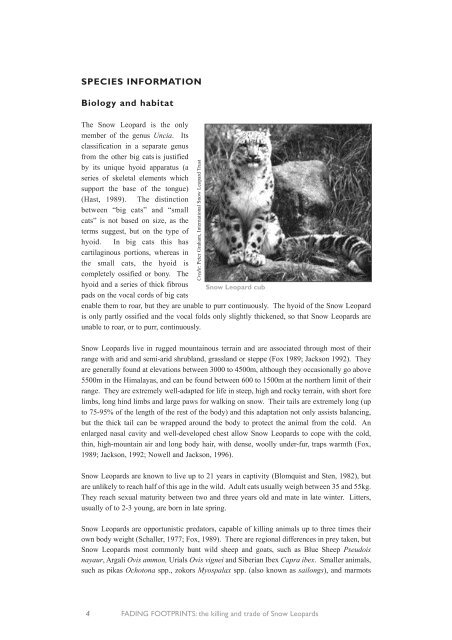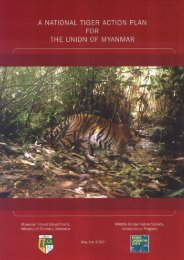Download - Global Tiger Initiative
Download - Global Tiger Initiative
Download - Global Tiger Initiative
Create successful ePaper yourself
Turn your PDF publications into a flip-book with our unique Google optimized e-Paper software.
SPECIES INFORMATION<br />
Biology and habitat<br />
The Snow Leopard is the only<br />
member of the genus Uncia. Its<br />
classification in a separate genus<br />
from the other big cats is justified<br />
by its unique hyoid apparatus (a<br />
series of skeletal elements which<br />
support the base of the tongue)<br />
(Hast, 1989). The distinction<br />
between “big cats” and “small<br />
cats” is not based on size, as the<br />
terms suggest, but on the type of<br />
hyoid. In big cats this has<br />
cartilaginous portions, whereas in<br />
the small cats, the hyoid is<br />
completely ossified or bony. The<br />
hyoid and a series of thick fibrous Snow Leopard cub<br />
pads on the vocal cords of big cats<br />
enable them to roar, but they are unable to purr continuously. The hyoid of the Snow Leopard<br />
is only partly ossified and the vocal folds only slightly thickened, so that Snow Leopards are<br />
unable to roar, or to purr, continuously.<br />
Credit: Peter Graham, International Snow Leopard Trust<br />
Snow Leopards live in rugged mountainous terrain and are associated through most of their<br />
range with arid and semi-arid shrubland, grassland or steppe (Fox 1989; Jackson 1992). They<br />
are generally found at elevations between 3000 to 4500m, although they occasionally go above<br />
5500m in the Himalayas, and can be found between 600 to 1500m at the northern limit of their<br />
range. They are extremely well-adapted for life in steep, high and rocky terrain, with short fore<br />
limbs, long hind limbs and large paws for walking on snow. Their tails are extremely long (up<br />
to 75-95% of the length of the rest of the body) and this adaptation not only assists balancing,<br />
but the thick tail can be wrapped around the body to protect the animal from the cold. An<br />
enlarged nasal cavity and well-developed chest allow Snow Leopards to cope with the cold,<br />
thin, high-mountain air and long body hair, with dense, woolly under-fur, traps warmth (Fox,<br />
1989; Jackson, 1992; Nowell and Jackson, 1996).<br />
Snow Leopards are known to live up to 21 years in captivity (Blomquist and Sten, 1982), but<br />
are unlikely to reach half of this age in the wild. Adult cats usually weigh between 35 and 55kg.<br />
They reach sexual maturity between two and three years old and mate in late winter. Litters,<br />
usually of to 2-3 young, are born in late spring.<br />
Snow Leopards are opportunistic predators, capable of killing animals up to three times their<br />
own body weight (Schaller, 1977; Fox, 1989). There are regional differences in prey taken, but<br />
Snow Leopards most commonly hunt wild sheep and goats, such as Blue Sheep Pseudois<br />
nayaur, Argali Ovis ammon, Urials Ovis vignei and Siberian Ibex Capra ibex. Smaller animals,<br />
such as pikas Ochotona spp., zokors Myospalax spp. (also known as sailongs), and marmots<br />
4 FADING FOOTPRINTS: the killing and trade of Snow Leopards

















